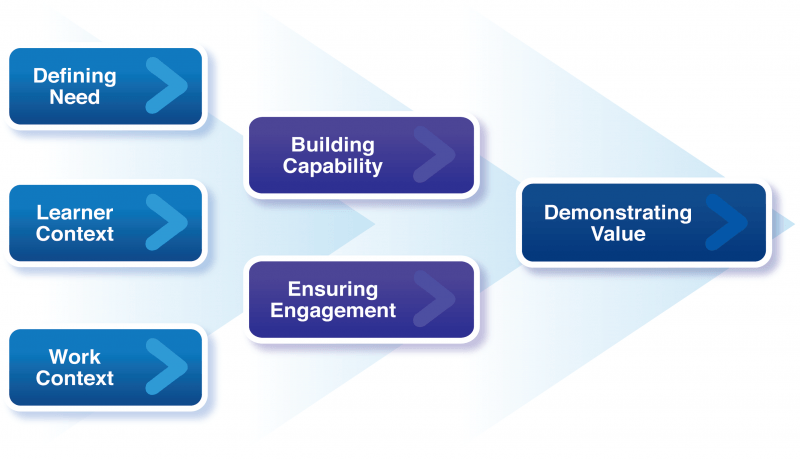Traditionally, Learning and Development teams have taken an inward-looking approach to measuring their effectiveness. They have analysed the things that matter to them, such as feedback on training courses, time spent on training courses, numbers of attendees on courses and so on. The problem in gathering this data, is the fact that it has very little relevance to the business. Why? Because the business wants to know the impact its investment in learning and development is having on business outcomes, not how successful a training course has been for those who attended it.
So how do you figure out the effectiveness of your Learning and Development function? To what extent are you able to demonstrate that you are adopting modernised learning approaches that deliver the outcomes the business needs: improved productivity, engagement; revenue and agility?
Data is Vital to Success
Data is vital; it provides the evidence you and your team need to understand impact and drive performance. An invaluable source of external, credible data is performance benchmarking – this provides robust, genuine and independent evidence on Learning and Development’s performance; the effectiveness and impact of the learning process. It enables organisations to reflect on their own performance and see how they compare against peers and top performing organisations.
However, in likeness to internal data-gathering, organisations are failing to grasp the opportunity on offer. Towards Maturity’s research shows that only 23% actively benchmark their learning strategy and practices against others in their industry, compared to 41% of top performing organisations. Only 17% actually use that benchmarking data for performance improvement, compared to 35% of top learning organisations.
So how can organisations use benchmarking to review their effectiveness?
Let’s start by defining it. Benchmarking is the process of comparing key performance indicators for one organisation with the indicators of others who are considered to represent the industry standard or best practice for that field. Business benchmarking focuses on 2 aspects: Key Performance Indicators (or KPI’s, comparing outcomes) and performance benchmarks (comparing activities).
This is nothing new; businesses have been benchmarking since the early 1990’s in order to develop new strategic direction and improve performance. Since 2003, Towards Maturity have been demonstrating effective practice benchmarking principles to help Learning and Development departments do the same.
Our benchmark helps organisations review their learning strategies, including the role of technology-enabled learning, through the application of our framework of effective practices. We define the Towards Maturity Model™ on six areas that we call workstreams, against which we measure the maturity of all organisations that benchmark. Below, we unfold these workstreams, which reflect the characteristics of more mature organisations.
It is important that benchmarks remain relevant and as future-proofed as possible, which is why we continually ask leading thinkers and practitioners in Learning and Development to sense-check our benchmark. This is critically important in an ever-changing world. Your effectiveness as an Learning and Development team must measure up to the current business context, not the business context of five years ago.
The Towards Maturity Model™
Defining Need
Mature organisations are more likely to align learning to business strategy, ensuring that programmes are relevant to both business and individual requirements.
Learner Context
Mature organisations are likely to have a greater focus on understanding the context of the learner, their motivations and environment.
Work Context
What are the work environment factors that might influence success? What needs to be changed? How should we go about it? Mature organisations ask these kind of questions.
Building Capability
Mature organisations target the changing needs of their learning and development professionals to ensure that they are to be equipped with the right skills, resources and reputation to effect change.
Ensuring Engagement
Mature organisations have proactive strategies for involving critical stakeholders who influence behaviour change.
Demonstrating Value
Mature organisations will be proactive in identifying the value their learning technologies are adding to their organisation.

The Towards Maturity Model™ helps L&D leaders adjust their practices to align with these six effective workstreams identified through extensive research on over 3,500 organisations since 2003.
We know that reflection is an essential part of learning; by using the framework of the Towards Maturity Model™ to reflect on the effectiveness of your learning strategy, you will learn what is working, what isn't and why. This generates insights that will have value for the wider business in terms of measuring outcomes. It will also help you make better decisions, which will help you become a more effective Learning and Development team or leader.
The Towards Maturity Benchmark™ is a useful tool to help you understand how effective your Learning and Development strategies are and how you compare to peers and top performing learning organisations.
If you are keen to find out how effective your Learning and Development team is, make sure you benchmark this year: it’s open until 31 July. More than 3,500 organisations have taken part to date, so there is plenty of data for you to benchmark against.








